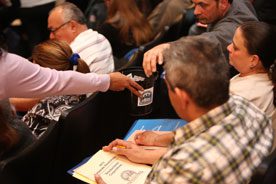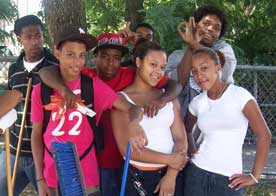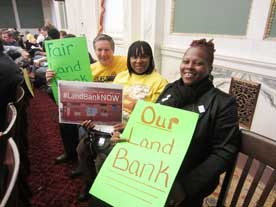When May Louie gives orientations to prospective trustees of the Dudley Street Neighborhood Initiative (DSNI), a Boston community-based planning and organizing nonprofit, she always shows them DSNI’s organizational flow chart. Most nonprofits would place the board of directors on top, above the executive director and other staff. But in DSNI’s chart, the word “Community” floats in a large blue bubble above everyone else. Next come “Members,” and below them, the “Board of Directors.” At the bottom sit “Staff” in a small rectangle.
“The simplicity of that chart tells us who is really in charge, which is the community,” says Louie, DSNI’s director of leadership and capacity building. DSNI has embraced a democratic organizational structure because “we want a community where people have a right to decide about schools, the quality of services, the kinds of businesses that come into the neighborhood, and who they hire—a neighborhood that’s engaged, believes it has a right to housing, green space, and quality services, and demands it, and demands it of us.”
Membership-Based Models: Once the Norm
Membership-based nonprofits, which elect their boards, are a rarity in the nonprofit world today, but they weren’t always. “One hundred years ago, they were super-common, 50 years ago, less common,” says Jon Pratt, executive director of the Minnesota Council of Nonprofits, who has written often about board governance. He notes that powerful political groups in American history, such as the agriculturally based Grangers and temperance associations, as well as fraternal groups, such as the Elks and Masons, were all membership-based.
“Over time, nonprofit organizations have pulled away from the community and engaged in more third-party representation,” Pratt says. “So we’re more an organization to help this community, but we’re not ‘by and of’ this community.”
Pratt, who advises people launching nonprofits, says they almost always avoid the membership model, preferring boards that are self-selecting. “At its most extreme, they say, ‘How can we set this up so no one can take this away from me, my wife, and my cousin?’” Pratt says. “They want ownership and control over their nonprofit, but they also want the recognition that comes with one.” People suspect that membership nonprofits are more work, and they’re right.
“Dictatorships are a far more efficient way to go,” Pratt says.
I spoke with leaders at four membership-based community development organizations—DSNI, People United for Sustainable Housing in Buffalo (PUSH Buffalo), Lawrence CommunityWorks (LCW) in Massachusetts, and Bickerdike Redevelopment Corp. in Chicago—to explore how their democratic structures influence their work. What are the advantages and disadvantages of membership-based structures? How do members influence issues pursued by a group? How do democratic nonprofit structures affect budgets, the role of staff, and power? And how do membership-based organizations change the people they serve?
Challenge #1: Membership-Based Organizations Are More Costly
Developing engaged members “takes money, time, and staff,” says Joe Kriesberg, executive director of the Massachusetts Association of Community Development Corporations (MACDC). Aaron Bartley, co-founder and executive director of PUSH Buffalo, a member-based CDC that has worked to build affordable housing on Buffalo’s West Side since 2005, concurs. PUSH started with two-and-a-half staffers, but within a few years Bartley realized that PUSH “didn’t have the staff to fully engage members.” It pursued funding from organizations such as the Catholic Campaign for Human Development, and after four years, raised enough to support three full-time organizers, a doubling of PUSH’s staff and budget.
Bartley says the challenge was to convince funders that mobilizing members was as important as providing services. “Organizing and community engagement can sometimes be seen as an abstraction . . . and it’s undervalued in our society and our funding culture,” Bartley says. “But it’s the way a community gets enough power to reverse the trends of disinvestment and poverty.” To convince foundations of organizing’s worth, Bartley highlighted an early success achieved by PUSH organizers: a campaign that convinced New York state in 2007 to give up control over 1,499 vacant Buffalo houses it owned and provide funding to help rehab them.
“We’re continuing to highlight the tangibility of the work,” Bartley says.
Challenge #2: Democracy Can Be Messy
Unfortunately, membership-based organizations are not immune to the political conflicts that surface in communities. “Running a member-based organization in a racially and economically diverse community is particularly complex,” Kriesberg notes. “Communities can be very fractured—new residents versus long-term ones, wealthy versus less wealthy, renter versus homeowner.” Such conflicts can sometimes paralyze, divide, or even destroy community organizations. Kriesberg also notes that majority rule in a membership-based organization sometimes conflicts with social justice. “Community involvement is a core value in our field,” Kriesberg says. “But two other values we advocate for are economic opportunity and inclusion. If we have to choose between ‘the community’ getting its way and getting racial and ethnic involvement, I’m going to choose the latter.”
At its founding in 1984, DSNI established a strong community-based democratic structure. Of 31 board positions, neighborhood residents were granted 16, a majority. Conscious of racial and ethnic tensions that had surfaced in their neighborhoods and in Boston historically, the founders took another step to ease potential political tensions within DSNI. They divided the 16 neighborhood board seats evenly, giving four seats each to the major ethnic groups in the area: African-Americans, Latinos, Cape Verdeans, and Caucasians.
“There was a conscious decision that we’d share power at our community table regardless of the percentage of people in the neighborhood,” Louie says. “Nobody looks back and regrets that decision.”
Since that time, DSNI has increased the diversity at its board table by adding four youth members, ages 15–17. Now 21 of 35 board members are residents.
Challenge #3: Membership-Based Groups Often Lack Expertise
Elected boards often lack the financial, political, and legal expertise found on self-selecting boards. That can be a problem, because elected boards have the same constellation of responsibilities as “resource boards,” which generally solicit trustees connected to power and money, such as bankers, wealthy donors, and politicians.
“Ours is a decision-making board,” Louie says of DSNI. “It meets monthly, approves budgets and work plans and initiatives, and major contracts. Just because it’s a community board, it’s not relegated to making less important decisions.”
Joy Aruguete, executive director of Bickerdike Redevelopment Corp., a CDC working to redevelop communities in northwest Chicago, says that elected members bring “a high level of commitment and dedication to the organization’s mission and work, but don’t necessarily come with the technical skill and knowledge.”
This is especially true in the highly regulated and financially complex world of housing, the bread-and-butter business for many CDCs. “People might not know what a performance bond is,” Aruguete says, “or the implications of what it means to pledge collateral on a loan. Development and property management is very complicated, so you have to hire people with a fairly high level of sophistication in these matters, but you don’t always have that on a board.”
To compensate, she and her staff spend a good deal of their time educating members and the board so they are prepared to make difficult decisions.
“This is why people don’t do this,” Aruguete says. “This is not the easy way.”
Advantage #1—Identifying Real Issues in the Community
Yet these leaders are convinced that the harder way often produces better results. Each January, when icy air and snow storms make picket lines and rallies difficult, PUSH Buffalo conducts its face-to-face membership drive, a litmus test for any such organization. “If you’re having trouble getting members,” Bartley says, “you’re doing something wrong.” As important as adding more members to the rolls, Bartley says, is “taking the time to sit down with each member, and find out what’s happening and get feedback.” These interactions help PUSH identify issues, evaluate its work, and fine-tune campaigns.
When Jessica Andors, executive director of Lawrence CommunityWorks (LCW) first came to that impoverished Massachusetts city in 1999, she and three other organizers assumed they’d develop low-income housing, the focus of the CDC they had inherited.
But they found out when they knocked on doors that people were more interested in things for their kids to do, Andors remembers. So organizers worked with parents to create a dynamic summer program for children, a pressing need. “We had one parent on the first field trip,” Andors says. “On the last one we had 23.”
From the trust built that summer, deeper conversations with residents began, Andors explains. “We asked them, ‘Where do you want to go?’ We started talking about the quality of life. We talked about crime, vacant lots, the need for parks, recreational facilities, where youth could go to be safe.”
At first, LCW organizers channeled their organizational efforts through a resuscitated neighborhood association, but they found that power issues, such as “who was going to be president,” got in the way of the work, Andors says. That’s when, inspired by the vision of Bill Traynor, then LCW’s executive director, they shifted to a “network” approach to membership, which focused on building relationships in the community.
“Our work over the last 10 to 15 years has not necessarily been around organizing around a specific issue,” Andors has written. “It’s about building people’s habits and practices around civic, neighborhood engagement, democratic deliberation, understanding local power structures, ways to negotiate and navigate those systems, and get involved.”
It’s worked: LCW now has over 5,000 members. Over the last dozen years it has generated over $70 million in new neighborhood investment, including a community center, three playgrounds, and 162 units of affordable housing—an issue they have picked up again.
Andors argues that truly listening to members means respecting their issues, even if they sometimes seem like “small potatoes.”
“Democracy in the community isn’t about Tiananmen Square actions,” Andors says. “It’s about quality-of-life ones that impact people’s daily lived experience in the neighborhood. They’re not all the stuff of national headline news, but they’re extremely important to making a community functioning and a place that people want to live in and stay in.”
She points out that less ambitious efforts often lead to more consequential ones. For example, about half-a-dozen years ago the first group of students went through LCW’s PODER program (“poder” is Spanish for “power”), which trains emerging leaders in the community. They began by organizing a March Against Garbage to improve the city’s garbage collection. That campaign led them to question the city’s budget process and priorities. That grew into the Fair Budget Campaign, which has led to institutionalizing hearings around budget priorities, translating the budget into Spanish, and posting Lawrence’s budget online.
In the last few years, members drove the decision by LCW to get involved in improving Lawrence’s troubled public schools, which went into receivership in 2011. “That was a huge decision for us,” Andors says. “I’m not sure we would have ventured so strongly into it, but we had the membership mandate and the receivership, so we had the opportunity to change something pretty fundamental.”
Advantage #2: Wiser Institutional Decisions
Democratically run institutions are also less likely to make unfair decisions. Marshall Ganz, a former leader of the Student Nonviolent Coordinating Committee (SNCC) and the United Migrant Farm Workers, and now a senior lecturer in public policy at the Kennedy School of Government, offers this analogy: If a local league is run by a wide swath of volunteer parents, decisions will most likely consider the interests of all the children. “If somebody says, ‘We need professionals,’ then you get money from two guys … Now, who starts deciding who gets on what teams, what the schedule is, and what the money pays for?”
For example, Susan G. Komen, one of the nation’s largest breast cancer charities, made a top-down decision in 2012 to pull breast exam funding from Planned Parenthood. The politically motivated pronouncement alienated many supporters, and has deeply damaged Komen’s ability to execute its mission.
DSNI’s Louie says the “collective wisdom” of membership organizations helps avoid such tone-deaf decisions. “No one can come in and say, ‘Do what I say.’ That’s why the community process is so important to people. We believe in the expertise people bring in and in their wisdom.”
Staff’s role is to educate members so they can make wise decisions.
“In our history, ideas have originated from everywhere—staff, board, residents, people inside the community and outside the community,” Louie says. “But once there are ideas on the table, the question is, who chooses? That’s the democracy part. I can have great ideas. I can say, ‘They should do backyard fish-farming; here’s how they do it in Hawai’i,’ but I can’t decide, and impose that decision. Our role is to look at many ideas, and help people weigh them and evaluate them and decide.”
Recently, DSNI’s board weighed whether to support a liquor license application from a struggling Roxbury convenience store owner. It was a tough decision: trustees wanted the store to thrive, but they didn’t want to support easy access to alcohol. The board made a nuanced decision: They declined to supoort the liquor license, but connected the owner with people who could help him formulate a successful business plan. “And we decided to buy local,” Louie adds.
“Nobody is reaching for an easy moralistic answer,” Louie says. “It’s not a patronizing discussion … It’s the community wrestling.”
Advantage #3: More People, More Power
Activists at these organizations also argue that membership-based groups can mobilize large numbers of people, which translates into power. “It’s not only an idealist commitment to a particular form of governance,” says PUSH’s Bartley, “but it’s a way to engage more people and to become a more powerful force for change.”
“There’s extra energy in the community, and if they feel that they’re really involved, you can get more done,” Pratt says. “You get more resources, monetary and non-monetary, and political legitimacy.” Ganz notes that historically, and today as well, mobilized volunteers are the best counter-balance to concentrated wealth. “‘Our people will walk to work rather than take a bus’—that was Montgomery,” Ganz explains. “‘Our people will go door-to-door, rather than do commercials.’ That’s how Obama was elected.”
Members act as community ambassadors. “Having members expands who we are,” says Aruguete. “It’s not just staff and the board who can talk about what we’re doing in the community.”
Democracy within a membership-based community organization can lead to more democracy outside it. “We get people more civically engaged not just in the work of the organization, but in the broader political system,” Aruguete says. With this in mind, Bickerdike committees are continuously promoting civic participation, including “getting people to vote,” says Aruguete. “I don’t think it’s gone unnoticed by our elected officials that we have about 3,000 people living in our housing, and that the large majority of them are registered to vote. Politicians look at voting blocks, and they look at the poll sheets.”
New leaders often rise from within these organizations. One October day eight years ago, Brenda Miller got a knock on her door from a PUSH Buffalo organizer campaigning to have National Fuel Gas (NFG), the local fuel provider, pay for home weatherization. Although she was unemployed and had three grandchildren under a year old in her home, NFG had just shut off her heat. The organizer convinced Miller to share her story at a rally two weeks later, where she discovered she wasn’t alone.
“It seemed a big weight was lifted off my shoulders,” she says. She also learned something about herself. “I was an activist, but I didn’t know I was.”
She ponied up $5 for her membership. “I belonged to something,” she says. Miller came to PUSH meetings, she volunteered, she canvassed. Two years ago, she was hired as a PUSH organizer, and was part of the campaign that forced NFG to pay $7.5 million in a 2013 settlement that included ratepayer refunds and weatherization funds. Part of her job now is to solicit new members.
What does she tell them?
“The more numbers we have, the more powerful we are.”
It’s a message more nonprofits would do well to learn.






Comments